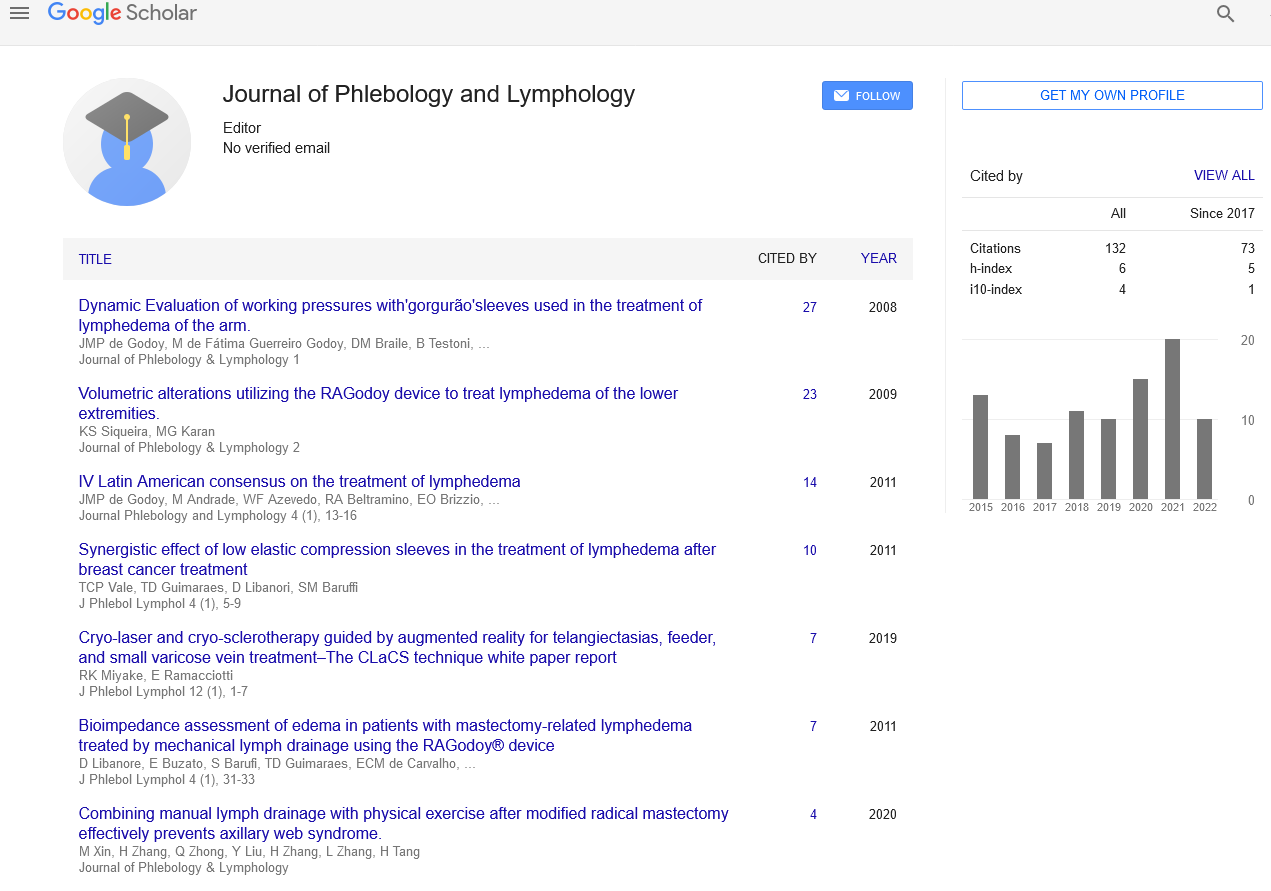After endoscopic knee surgery, acute leg edema: a complication and treatment strategy
Received: 05-May-2023, Manuscript No. puljpl-23-6790; Editor assigned: 08-May-2023, Pre QC No. puljpl-23-6790 (PQ); Accepted Date: May 27, 2023; Reviewed: 23-May-2023 QC No. puljpl-23-6790 (Q); Revised: 26-May-2023, Manuscript No. puljpl-23-6790 (R); Published: 29-May-2023
Citation: Pensri P. After endoscopic knee surgery, acute leg edema: a complication and treatment strategy. J Phlebol Lymphology. 2023; 16(2):01-02.
This open-access article is distributed under the terms of the Creative Commons Attribution Non-Commercial License (CC BY-NC) (http://creativecommons.org/licenses/by-nc/4.0/), which permits reuse, distribution and reproduction of the article, provided that the original work is properly cited and the reuse is restricted to noncommercial purposes. For commercial reuse, contact reprints@pulsus.com
Abstract
Acute leg edema is an uncommon but potential complication following endoscopic knee surgery. This article discusses the occurrence of sudden leg edema after endoscopic knee surgery, its possible causes, and management strategies. The importance of early recognition and appropriate intervention to mitigate this complication is emphasized. this post, we'll delve into the interesting world of the lymphatic vein—its composition, purposes, and relevance in warding off diseases and infections.
Key Words
Endoscopic knee surgery; Acute leg edema; Complications; Management; Postoperative edema; Knee arthroscopy
Introduction
Endoscopic knee surgery, including knee arthroscopy, has revolutionized the management of knee conditions, offering minimally invasive procedures with faster recovery times. However, like any surgical procedure, endoscopic knee surgery is not without its complications. One uncommon yet notable complication is the sudden onset of leg edema following the surgery. This article aims to shed light on the occurrence, potential causes, and appropriate management of acute leg edema post endoscopic knee surgery.The vein of lymph is characterized by its thin walls, lack of red blood cells, and the presence of valves. These valves ensure the unidirectional flow of lymph, preventing any backward movement. Lymphatic vessels gradually merge to form larger vessels, resembling the branches of a tree, ultimately leading to the formation of two main lymphatic ducts: the thoracic duct and the right lymphatic duct. These ducts drain lymph into the bloodstream, connecting the lymphatic and circulatory systems.
Causes and Presentation Acute leg edema, also known as sudden leg swelling, can be a distressing postoperative complication following endoscopic knee surgery. It typically presents within the first few hours to days after the procedure. The edema is characterized by an abnormal accumulation of fluid in the tissues of the leg, leading to noticeable swelling, pain, and discomfort.
Several potential causes may contribute to the sudden onset of leg edema following endoscopic knee surgery:them to travel to other parts of the body and form secondary tumors. Sentinel lymph node biopsy, a common procedure in cancer staging, involves identifying and removing the first lymph node(s) to which cancer is most likely to spread. Maintaining a Healthy Vein of Lymph (200 words): Taking care of the vein of lymph is essential for overall health and immune function. Regular exercise, such as walking or swimming, helps stimulate lymphatic flow, preventing stagnation and promoting proper fluid drainage. Maintaining a healthy weight is also crucial, as obesity can contribute to lymphatic dysfunction and lymphedema. In cases of lymphatic disorders, specialized therapies such as manual lymphatic drainage, compression therapy, and complete decongestive therapy can provide relief and help manage symptoms. These therapies aim to improve lymphatic flow, reduce swelling, and enhance overall lymphatic function. The surgical procedure itself can disrupt the venous and lymphatic systems in the knee, leading to impaired circulation and fluid retention in the leg. The altered drainage mechanisms can result in edema. Surgery triggers an inflammatory response in the body, and this postoperative inflammation can cause localized swelling in the leg. Inflammatory mediators can promote fluid accumulation in the tissues. The patient's position during endoscopic knee surgery may put pressure on specific areas, hindering blood flow and lymphatic drainage. Prolonged pressure can contribute to leg edema In rare cases, acute leg edema may be a result of compartment syndrome, where increased pressure within the compartments of the leg impairs blood flow, leading to severe swelling and potential damage to muscles and nerves.
Management and Intervention Strategies: Early recognition and appropriate management of acute leg edema following endoscopic knee surgery are crucial to prevent complications and ensure a smooth recovery. The following strategies can be employed like Elevating the affected leg and applying ice packs can help reduce swelling and inflammation. Elevating the leg above heart level promotes drainage and minimizes edemaRegular monitoring of the edema, wound healing, and patient progress is vital. Prompt follow-up appointments allow healthcare providers to assess the progress and adjust the management plan accordingly. Anti-inflammatory medications prescribed by the surgeon can help manage postoperative inflammation and associated discomfort.Gentle exercises and mobility-enhancing activities guided by a physical therapist can assist in promoting blood circulation and reducing edema. Gradual movement helps prevent stiffness and discomfort.
Conclusion
Acute leg edema following endoscopic knee surgery is a rare but significant complication that requires vigilant monitoring and timely intervention. Understanding the potential causes and employing appropriate management strategies, including elevation, compression, physical therapy, and medication, can help mitigate the effects of edema and facilitate a smoother recovery for the patient. It is crucial for healthcare professionals to remain vigilant and proactive in managing this complication to ensure optimal postoperative outcomes for individuals undergoing endoscopic knee surgery.





